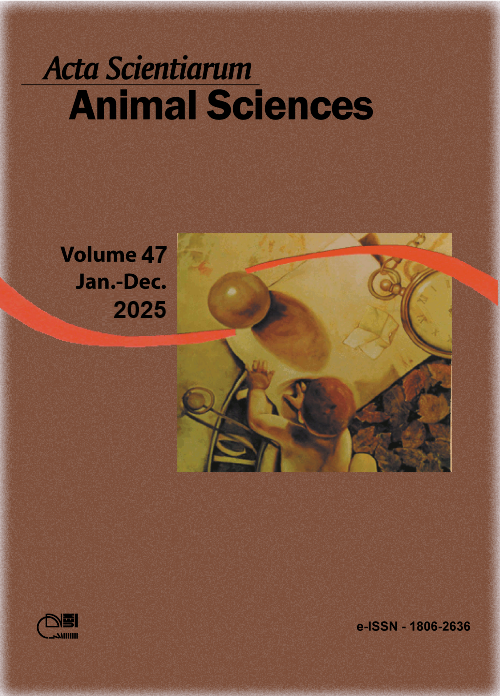Role of infection with Hymenolepis nana in alteration of some Biochemical, Immnunological and Histological parameters in Mice/Balb-C
Resumo
The current study was conducted from November 2023 to February 2024 on 20 male laboratory mice. The current study evaluated the effect of infection with the dwarf worm on some biochemical and immunological parameters and some histological changes of the liver and intestine of laboratory mice. During the current study, liver enzymes, some cellular motility and immunoglobulin E were measured using ELISA technology by providing a set of work from well-known international companies. Histological sections of the liver and intestine of mice were also prepared for both the control and dwarf worm-infected groups. The current study showed significant differences between the levels of enzymes, cellular motility and immunoglobulin E levels by comparing the results of the infected group with the control group. In addition, the current study also showed changes in the liver and intestine tissues by comparing with the control group as well. It appears from the results of the current study that infection with the dwarf worm causes changes in liver functions and stimulates the immune response in addition to histological changes in both the liver and intestine.
Downloads
Referências
Abdel-Latif, M., El-Shahawi, G., Aboelhadid, S. M., & Abdel-Tawab, H. (2017). Immunoprotective Effect of Chitosan Particles on Hymenolepis nana – Infected Mice. Scandinavian Journal of Immunology, 86(2), 83-90. https://doi.org/10.1111/sji.12568
Ahmed, A. K., Abdel-Hafeez, E. H., & Kamal, A. M. (2015). Some studies of spontaneous Hymenolepis diminuta infection in laboratory rats. Journal of the Egyptian Society of Parasitology, 45(1), 115-124. https://doi.org/10.12816/0010857
Al-Olayan, E., Almushawah, J., Alrsheed, H., Dawoud, T. M., & Abdel-Gaber, R. (2023). Potential role of biosynthesized silver nanoparticles from Aaronsohnia factorovskyi on Hymenolepis nana in BALB/c mice. Arquivo Brasileiro de Medicina Veterinária e Zootecnia, 75(5), 849-856. http://dx.doi.org/10.1590/1678-4162-13041
Bain, B. J., Bates, I., & Laffan, M. A. (2017). Dacie and Lewis Practical Haematology (12th ed.). Elsevier Ltd.
Bancroft, J., & Stevens, A. (1987). Theory and practice of histological technique (482-502). Churchill Livingstone.
Bayoumy, A. M. S., Hamza, H. T., & Alotabi, M. A. (2020). Histopathological and biochemical studies on immunocompetent and immunocompromised Hymenolepis nana infected mice treated with Commiphora molmol (Mirazid). Journal of Parasitic Diseases, 44(2), 837-849. https://doi.org/10.1007/s12639-020-01263-z
Bimi, L., Yeboah, J. A., Adongo, L. A., Ofori, B. Y., Oduro, D., Tetteh, A. K., & Owusu, E. H. (2021). Gastrointestinal parasites of three peri‑domestic animals in selected areas in Accra, Ghana. The Journal of Basic and Applied Zoology, 82(48), 1-7. https://doi.org/10.1186/s41936-021-00247-6
Bhosel, N. K. (2022). Humenolepiasis. In S. C. Parija, & S. B. Vidyapeeth (Eds.), Textbook of Parasitic Zoonoses (p. 385-392). Springer Nature Singapore Pte Ltd. https://doi.org/10.1007/978-981-16-7204-0
Chaudhury, A. (2022). Parasite immunology. In S. C. Parija, & S. B. Vidyapeeth (Eds.), Textbook of parasitic zoonoses (p. 3-21). Springer Nature Singapore Pte Ltd. https://doi.org/10.1007/978-981-16-7204-0
Cleophas, T. J., & Zwinderman, A. H. (2016). SPSS for starters and 2nd levelers (2nd Ed.). Springer Cham Heidelberg. https://doi.org/10.1007/978-3-319-20600-4
Coello-Peralta, R. D., Martínez-Cepeda, G. E., Pinela-Castro, D., Reyes-Echeverria, E. O., Rodríguez-Burnham, E. X., Mazamba, M. D. S., Pazmiño-Gómez, B., Ramírez-Tigrero, A., Bernstein, M., & Cedeño-Reyes, P. (2020). Presence of Hymenolepis nana and Hymenolepis diminuta in rodents of the Las Pinas citadel, in Milagro, Ecuador, and its risk for public health. Revista Mexicana de Ciencias Pecuarias, 11(4), 961-970. https://doi.org/10.22319/rmcp.v11i4.5182
Fitte, B., Robles, M. R., Dellarupe, A., Unzaga, J. M., & Navone, G. T. (2018). Hymenolepis diminuta and Rodentolepis nana (Hymenolepididae: Cyclophyllidea) in urban rodents of Gran La Plata: association with socio-environmental conditions. Journal of Helminthology, 92(5), 549-553. https://doi.org/10.1017/S0022149X17000864
Kapczuk, P., Kosik-Bogacka, D., Łanocha-Arendarczyk, N., Gutowska, I., Patrycja Kupnicka, P., Chlubek, D., & Baranowska-Bosiacka, I. (2018). Selected Molecular Mechanisms Involved in the Parasite–Host System Hymenolepis diminuta–Rattus norvegicus. International Journal of Molecular Sciences, 19(8), 2435, 1-21. https://doi.org/10.3390/ijms19082435
Karim, A., Zartashiaa, B., Khwajab, S., Akhterb, A., Razac, A. A., & Parveen, S. (2024). Prevalence and risk factors associated with human Intestinal Parasitic Infections (IPIs) in rural and urban areas of Quetta, Pakistan. Brazilian Journal of Biology, 84(e266898), 1-5. https://doi.org/10.1590/1519-6984.266898
Khan, W., Nisab, N. N., Pervezc, S., Ahmedd, S., Ahmede, M. S., Alfarrajf, S., Alig, A., & Tahreemh, S. (2020). Occurrence of Hymenolepis diminuta: a potential helminth of zoonotic importance in murid rodents. Brazilian Journal of Biology, 82(e242089), 1-5. https://doi.org/10.1590/1519-6984.242089
Mehlhorn, H. (2022). Human parasites (2a ed.). Springer Nature. https://doi.org/10.1007/978-3-031-41705-4
Pérez-Chacón, G., Pocaterra, L. A., Rojas, E., Hernán, A., Jiménez, J. C., & Núñez, L. (2017). Case Report: Coinfection with Hymenolepis nana, Hymenolepis diminuta, Giardia intestinalis, and Human Immunodeficiency Virus: A Case Report with Complex Immunologic Interactions. The American Society of Tropical Medicine and Hygiene, 96(5), 1094-1096. http://ajtmh.org/cgi/doi/10.4269/ajtmh.16-0413
Roberts, L. S., Janovy Jr, J., & Nadler, S. (2013). Schmidt and Robert’s Foundations of Parasitology (9th ed.). McGraw-Hill Co., Inc.
Sarrafan, A., Ghobeh, M., & Yaghmaei, P. (2021). The effect of 6-gingerol on biochemical and histological parameters in cholesterol-induced nonalcoholic fatty liver disease in NMRI mice. Brazilian Journal of Pharmaceutical Sciences, 57(e18020), 1-15. http://dx.doi.org/10.1590/s2175-979020200003181020
World Heath Organization [WHO]. (1991). Basic laboratory methods in medical parasitology. WHO.
Yadav, S. A., Rajat, R. K., Ganai, A., & Imtiaz, S. (2018). Hymenolepis nana infection in laboratory rats: A case report. Journal of Entomology and Zoology Studies, 6(4), 1202-1204. https://doi.org/10.7759/cureus.3810
Copyright (c) 2025 Maroof Sabti Juma Al-Ammash

This work is licensed under a Creative Commons Attribution 4.0 International License.
DECLARAÇÃO DE ORIGINALIDADE E DIREITOS AUTORAIS
Declaro que o presente artigo é original, não tendo sido submetido à publicação em qualquer outro periódico nacional ou internacional, quer seja em parte ou em sua totalidade.
Os direitos autorais pertencem exclusivamente aos autores. Os direitos de licenciamento utilizados pelo periódico é a licença Creative Commons Attribution 4.0 (CC BY 4.0): são permitidos o compartilhamento (cópia e distribuição do material em qualqer meio ou formato) e adaptação (remix, transformação e criação de material a partir do conteúdo assim licenciado para quaisquer fins, inclusive comerciais.
Recomenda-se a leitura desse link para maiores informações sobre o tema: fornecimento de créditos e referências de forma correta, entre outros detalhes cruciais para uso adequado do material licenciado.








































